Wassail Bowl
Le ricette d’epoca: LAMBS WOOL
THE WASSAIL SONGS
♬A jolly wassel bowl
La coppa della salute e il brindisi per augurare Buon Natale e per festeggiare l’anno nuovo
Per comprendere appieno le tradizioni del wassail in sintesi possiamo guardare il Dizionario di Samuel Johnson, pubblicato nel 1756, dove dice che “Wassail” era: “un liquore fatto di mele, zucchero e birra; un incontro di ubriachi; una canzone allegra” .
La parola wassail deriva dalle parole molto più antiche, dall’Inglese Antico (anglosassone) wæs (þu) hæl che significa “essere in buona salute” o “essere integri” – mentre il primo riferimento al wassailing risale ad un rapporto medievale del 1486-93, per i pagamenti del wassail fatti per l’anno nuovo, a St Mary De Pre Priory (a St Albans) [1]
Dal norreno antico vas heil (buona salute nel senso “stammi bene”) all’Inglese antico “Waes Hael” (salute nel senso di un brindisi) è il nome dato sia al brindisi che alla coppa che contiene la bevanda del brindisi.
In origine si ritiene che i brindisi si svolgessero nei frutteti dove si brindava per la salute e la prosperità degli alberi [2], poi si passò alle visite benaugurali di porta in porta nei villaggi, che ripetevano le antiche strofe ed altre ne aggiungevano, alla salute dei padroni di casa e alla loro prosperità.
Dal wassailing porta a porta, la wassail bowl (= grolla della salute) entra nelle case sulla tavola di Natale come bevanda per i commensali!
Per Natale e Capodanno in Gran Bretagna e Stati Uniti-Canada l’usanza del Wassaling non muore mai!
Wassel bowl and the toast to wish a good Christmas revel to celebrate the New Year!
To fully understand the traditions of the wassail in summary we can look at Samuel Johnson’s Dictionary, published in 1756, which says the ‘Wassail’ was: “a liquor made of apples, sugar, and ale; a drunken bout; a merry song”.
Yet the word wassail derives from the much older, ‘Old English’ (Anglo-Saxon) words wæs (þu) hæl which means ‘be healthy’ or ‘be whole’ – both of which meanings survive in the modern English phrase to be, ‘hale and hearty’ – while the first written reference to wassailing dates back to a medieval 1486-93 AD record, for wassail payments made at the New Year, at St Mary De Pre Priory (in St Albans)[1].
In Old English “Waes Hael” means “Good Health” it is the name given to both the toast and the cup that contains the drink. Originally the toast was held in the orchards where they feasted for the health and prosperity of the trees[2], then they went to the door to door visits in the villages, where they repeated the old stanzas and added others, to the health of the landlords and their prosperity.
From door to door wassailing, the wassail bowl (= health grille) enters the houses on the Christmas table as a drink for the diners!
For Christmas and New Year in the Great Britain and USA the custom of Wassailing is still alive!
WASSAIL BOWL
Nel Medioevo gruppi di questuanti cantavano e suonavano per le strade e portavano la grolla della salute (wassail bowl) di casa in casa, cantando per reclamizzarne la bontà e per augurare una buona festa di Natale e un felice Anno Nuovo, in attesa di una piccola ricompensa.
A volte una coppa svasata, già nel Medioevo la “jolly wassel bowl” prende forma di grande pisside intagliata nel legno.
Anche la grolla valdostana (tipica della Val D’Aosta e del Canavese) ha forme simili, alta e stretta scolpita nel legno (noce o acero) ha come bevanda principe il vin brulè; derivata da quella la “coppa dell’amicizia” è invece più panciuta e con vari beccucci per bere il caffè alla valdostana “à la ronde”, ovvero facendo passare la coppa di mano in mano, senza mai appoggiarla sul tavolo.
Probabilmente grolla deriva dal termine graal cioè calice, in lingua d’oil (francese arcaico) significa proprio “recipiente” o “coppa”.
L’uso della grolla è storicamente documentato fin dall’Alto Medioevo degli oggetti in uso nei castelli.
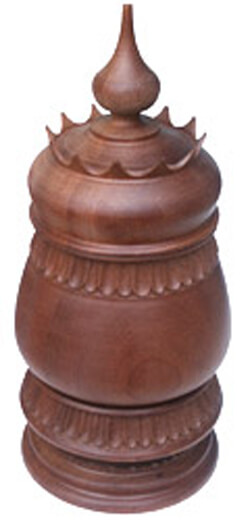
Nel Settecento e in epoca vittoriana predomina in Gran Bretagna il modello di grolla in terracotta invetriata con manici, spesso abbondantemente decorata. Il coperchio a forma di alta cupola, ed è fondamentale per tenere al caldo la bevanda mentre i numerosi manici favoriscono il passaggio di mano in mano della coppa stessa. Per prima cosa, il capofamiglia alzava la ciotola di wassail e beveva alla salute di tutti i presenti – come un moderno brindisi – poi la ciotola veniva passata per la stanza e tutti bevevano.

In the Middle Ages groups of beggars sang and played in the streets and carried the wassail bowl from house to house, singing to advertise goodness of the drink and to wish a good Christmas party and a Happy New Year, waiting for a small reward.
Sometimes a flared cup, already in the Middle Ages the “jolly wassel bowl” takes the form of a large pyx carved in the wood.
Also the “grolla valdostana” (typical of Val D’Aosta and Canavese. Italy) has similar shapes, high and narrow carved in the wood (walnut or maple), its main drink is the mulled wine; the “cup of friendship” is a derivation of this one, but more pot-bellied and with various spouts to drink coffee “à la ronde“, by passing the cup from hand to hand, without ever resting it on the table.
Probably grolla comes from the word “graal” that is calyx, in the language of oil (archaic French) means “container” or “cup”.
The use of the grolla is historically documented since the Middle Ages of the objects in use in the castles.

In the eighteenth century and in the Victorian era, the glazed earthenware
model with handles is predominated in Great Britain, often abundantly decorated. The high dome-shaped lid is essential to keep the drink warm and the numerous handles favor the passage from hand to hand of the cup itself.
First, the head of the household would raise the wassail bowl and drink to the health of everyone present – like a modern-day toast – then the bowl would be passed around the room, and everyone would take a drink.
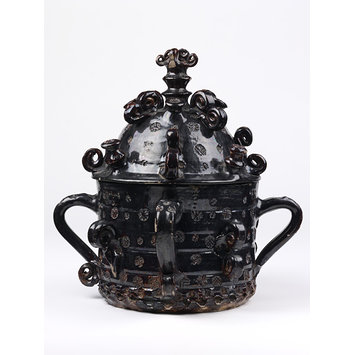
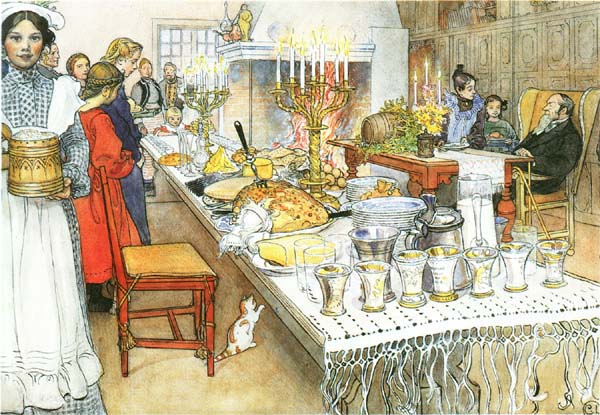
A jolly wassel bowl
Inizialmente erano i questuanti a portare la grolla di casa in casa (una simbolica condivisione comunitaria della bevanda e delle provviste così come si faceva nei tempi delle società tribali).
Nelle Midland occidentali dell’Inghilterra è ancora diffuso il canto di questua “Jolly wassel-bowl” con un testo risalente probabilmente al 1600.
Initially, therefore, the wassailers were carrying the bowl through the village as a symbolic communal sharing of goods.
In the West Midlands of England there is still widespread singing “Jolly wassel-bowl” with a text probably dating back to 1600.
Traduzione italiana Cattia Salto
1.La grolla della salute, una coppa di buona birra
conforterà l’anima del maggiordomo,
la coppa dell’allegria che abbiamo da vendere(1)
2.Buona madama, qui alla vostra porta
inizia la nostra questua, siamo tutte poverelle
e vi preghiamo di farci entrare con la nostra coppa
3.La nostra coppa riempiamo di mele e spezie(3)
concedeteci la vostra buona volontà di assaggiare qualche sorso della nostra buona bevanda
4.Se in questa magione dimorano delle fanciulle
di certo concorderanno
di prendere un buon sorso della nostra bevanda
5.Ma qui stiamo in attesa a gelare al freddo
Buon messere date l’ordine
di farci entrare con la nostra bevanda
6.Tanta gioia in questa casa è entrata con noi;
voi Messere, per primo
speriamo inizierete il brindisi
7.Poi la sua sposa assaggerà la nostra grolla speziata
Dio vi allunghi la vita
Buona fortuna scorgiamo per la questua
8.Dei doni dalle vostre mani per sostenere il nostro wassail,/ non compreremo case o terre
con ciò che guadagneremo con la questua
9. Questa sarà la nostra allegra sera di scegliere il Re e la Regina(4) che possiate allora compiacervi
di dare qualcosa per la nostra questua
10. E’ assai nobile avere un’animo liberale
che Dio vi benedica signori, perchè qui abbiamo trovato soddisfazione con la nostra questua
11. E ora dobbiamo andare in cerca di altra allegria
dove ci sarà mostrata altrettanta generosità
di quella che qui abbiamo trovato con la questua
12.Tanta gioia per tutti voi le nostre preghiere saranno di pace,/speranza e ogni bene
per la vostra grande generosità alla nostra questua
Il testo è antico e si trova in diverse raccolte tra cui “Christmas Carols Ancient and Modern” (1833) con la nota di William Sandys: Stampato in Ancient Songs di Ritson pp. 304-6. Da una raccolta intitolata “New Christmas Carols:” adatta ad essere cantata a Pasqua, Pentecoste e altre festività dell’anno. “”nel singolare studio dello stimato antiquario, Mr. Anthony á Wood [1632-1695], nel Museo Ashmoleian.[3]
NOTE
(1) nelle versioni più antiche sono i questuanti, per lo più le donne accompagnate dai figli piccoli, a preparare la grolla della salute e a portarla di casa in casa per il brindisi benaugurale
(3) nel Medioevo il liquido principale della grolla era birra calda aromatizzata con mele e spezie.
(4) il re del fagiolo e la sua regina nella festa dell’Epifania o della Dodicesima Notte[4]
1.A jolly wassel bowl, A wassel of good ale,
Well fare the butler’s soul,
That setteth this to sale (1); Our jolly wassel(2).
2.Good dame, here at your door
Our wassel we begin, We are all maidens poor,
We pray now let us in, With our wassel.
3.Our wassel we do fill With apples and with spice (3),
Then grant us your good will
To taste here once or twice Of our good wassel.
4.If any maidens be Here dwelling in this house,
They kindly will agree
To take a full carouse, Of our wassel.
5.But here they let us stand All freezing in the cold:
Good master give command
To enter and be bold, With our wassel.
6.Much joy into this hall With us is entered in;
Our master, first of all,
We hope will now begin Of our wassel.
7. And after his good wife Our spiced bowl will try;
The Lord prolong your life,
Good fortune we espy For our wassel.
8.Some bounty from your hands, Our wassel to maintain:/We’l buy no house nor lands
With that which we do gain With our wassel.
9.This is our merry night Of choosing king and queen(4),
Then be it your delight
That something may be seen, In our wassel.
10.It is a noble part, To bear a liberal mind,
God bless our masters heart,
For here we comfort find, With our wassel.
11.And now we must be gone To seek out more good cheer,/Where bounty will be shown,
As we have found it here, With our wassel.
12. Much joy betide them all, Our prayers shall be still,
hope and ever shall,
For this your great good will To our wassel.
(1) in the older versions are the beggars, mostly the women accompanied by their young children, to prepare the bowl and to take it for the wassail visiting
(2) wassel = wassail
(3) in the Middle Ages the main drink was hot beer flavored with apples and spices.
(4) the king of the bean and his queen on the feast of Epiphany or Twelfth Night
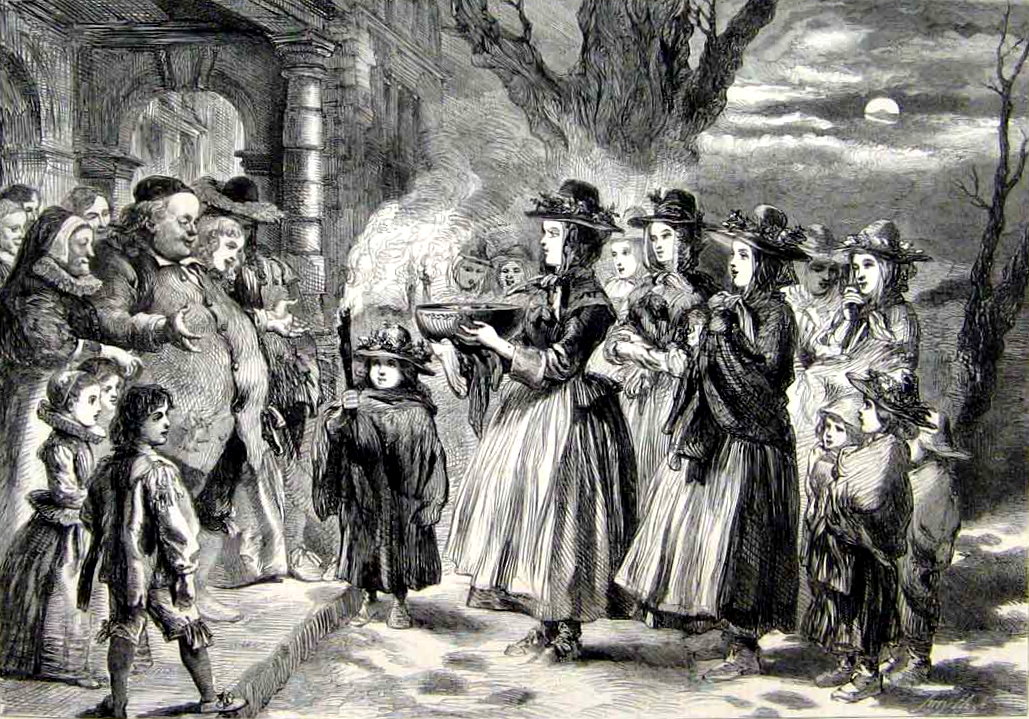
Nell’Ottocento i più poveri andavano a cantare il wassail con la grolla vuota chiedendo qualcosa per aiutarli a riempirla, ma il Natale vittoriano finì con il sostituire il “caroling”[5] ossia i canti di Natale di natura religiosa al wassailing.
Da allora il wassail è rimasto confinato nelle case per bere alla salute di amici e familiari durante le festività natalizie!!
In the 19th century the poorest went to sing wassail with an empty bowl asking for something to help them fill it.
But it was the Victorian Christmas that replaced wassailing with “caroling”[5], the Christmas carols of a religious nature.
Since then wassail has remained confined to homes to drink to the health of friends and family during the holiday season!!
Lambs wool? Ricette per il wassail
Nel Medioevo era una bevanda speziata e calda di birra, idromele e sidro.
La ricetta prevede la cottura in forno delle mele ridotte successivamente in purea, l’aggiunta alla birra e/o sidro con noce moscata, zenzero e zucchero. Si mette la bevanda sul fuoco dolce per una trentina di minuti e si dà una bella frullata prima di servire.[6]
La ricetta tipica che si preparava all’epoca per la wassail bowl era detta Lambswool per il colore chiaro e spumoso della sua superficie. Ma secondo Richard Cook il nome potrebbe essere una corruzione di lamasool cioè “La mas ubal” ( “Il giorno delle mele”) la festa celtica dell’Apple Howling
Poi riempi la boccia fino all’orlo con la dolce “lana d’agnello”: aggiungi zucchero, noce moscata e zenzero
e anche tanta birra; così si deve fare per una grolla festosa.
(Robert Herrick, “Twelfe-Night” 1648)
The typical recipe that was prepared at the time for the wassail bowl was called Lambswool for the light color and frothy of its surface, but according to Richard Cook the name could be a corruption of lamasool that is “La mas ubal” (“The day of the apples”) the Celtic revel of the Apple Howling
Next crown a bowl full with gentle lamb’s wool :
Add sugar, nutmeg, and ginger, with store of ale too ;
And thus ye must do to make the wassail a swinger.
(Robert Herrick, “Twelfe-Night” 1648)
Mulled Cider
THE WASSAIL SONGS
La struttura di questi canti di questua è tipica: si inizia con delle strofe che decantano la bontà della bevanda portata, la richiesta di aprire la porta per far entrare i questuanti o quantomeno far venire la cameriera (o il maggiordomo) per portare del cibo o un’offerta in denaro; in cambio si brinda alla salute della famiglia, alla prosperità del bestiame e dei raccolti. (c’erano ovviamente anche le strofe delle maledizioni nel caso l’offerta non fosse abbastanza generosa!)
The structure of these songs is typical: it starts with some stanzas that praise the goodness of the drink , the request to open the door to let the beggars enter in or at least that the waitress (or the butler) to bring food or money; in return, they drink to the health of the family, to the prosperity of livestock and crops. (there were obviously also the stanzas of the curses if the offer was not generous enough!)
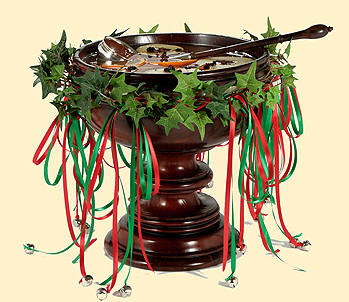
![]() WASSAIL SONGS
WASSAIL SONGS
God bless the master of this house
A jolly wassel bowl
GLOUCHESTERSHIRE WASSAIL
THE YORKSHIRE WASSAIL SONGS:
Gooding carols
Here we come a-wassailing
We’ve been a-while a-wandering
Wessel cup carol
SOMERSET WASSAIL:
Somerset wassail
Apple tree wassail
SUSSEX
Sugar wassail
[1] http://oakden.co.uk/lambswool/
[2] La forma più antica della celebrazione dell’Apple tree wassail prevede la benedizione degli alberi e delle api, così importanti per l’impollinazione, al fine di garantire un buon raccolto per il prossimo anno.
https://terreceltiche.altervista.org/gennaio-il-mese-del-wassailing-nei-frutteti/
[3] A Carrol for a Wassel-Bowl, To Be Sung Upon Twelfth-Day at Night. Words and Music: Traditional English
“about the time of Henry VI.,” according to Ritson Music: “To the Tune of, Gallants come away.”
https://www.hymnsandcarolsofchristmas.com/Hymns_and_Carols/a_jolly_wassel_bowl.htm
[4] c’erano due dolci per eleggere il re e la regina della dodicesima notte, uno per gli uomini (con un fagiolo nascosto all’interno) e uno per le donne (con un pisello nascosto all’interno). Se c’era un’unica torta con il fagiolo nell’impasto il primo che l’avesse trovato avrebbe a suo piacere nominato il compagno da incoronare.
Diversi dipinti fiamminghi illustrano con dovizia di particolari i commensali attorno al tavolo mentre festeggiano il Re Fagiolo. Sono dipinti variamente intitolati “La dodicesima notte” o “il Re Beve” a causa dei numerosi brindisi fatti in suo onore e secondo i suoi ordini, i personaggi sono ritratti in pose sguaiate visibilmente ubriachi e satolli di cibo. Ma nell’andare del tempo la festa è diventata un gioco di società e una festa per bambini piuttosto che un baccanale. https://terreceltiche.altervista.org/fetta-dolce-della-dodicesima-notte/
[5] https://terreceltiche.altervista.org/sussex-carol/
[6] la ricetta più antica https://oakden.co.uk/lambswool/
le ricette più elaborate ispirate a ricette seicentesche aggiungono uova e panna al sidro https://oakden.co.uk/lambs-wool/
LINK
http://www.cbladey.com/wassail.html
http://mudcat.org/thread.cfm?threadid=97570
https://www.hymnsandcarolsofchristmas.com/Hymns_and_Carols/Notes_On_Carols/wassailing.htm
